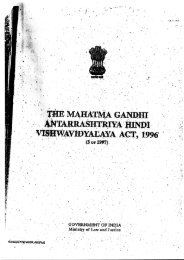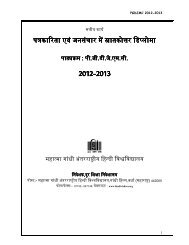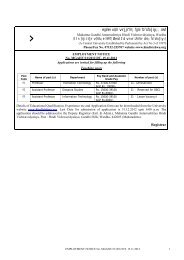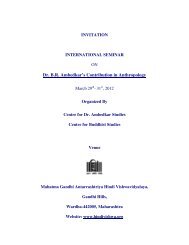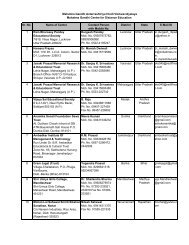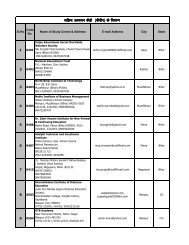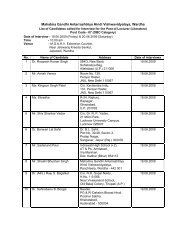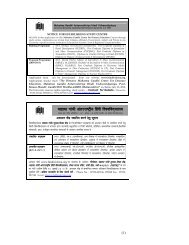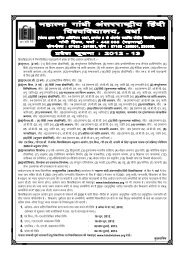A Journal of Mahatma Gandhi Antarrashtriya Hindi Vishwavidyalaya
A Journal of Mahatma Gandhi Antarrashtriya Hindi Vishwavidyalaya
A Journal of Mahatma Gandhi Antarrashtriya Hindi Vishwavidyalaya
You also want an ePaper? Increase the reach of your titles
YUMPU automatically turns print PDFs into web optimized ePapers that Google loves.
untouchable boy. The boy is from ‘bhangi’<br />
(scavanger) community and he is an orphan<br />
also. In this novel the novelist explicitly<br />
and without mincing words depicts the<br />
attitude <strong>of</strong> so called upper caste society<br />
and individuals towards the untouchables.<br />
This novel clearly criticizes the attitude<br />
<strong>of</strong> the society through protagonist Munnu,<br />
who is orphan, poor, weak and above<br />
all belongs to the untouchable community.<br />
When a doctor gives shelter to this poor<br />
boy when he found him injured and lying<br />
unconscious outside his house the<br />
Brahmans (priestly class) and other upper<br />
caste members make a hue and cry and<br />
press the doctor to abandon this boy.<br />
This has been seen as ‘degeneration <strong>of</strong><br />
dharm’ by the upper caste brahmans. In<br />
this way this novel becomes the mirror<br />
<strong>of</strong> backward Indian societal attitude. In<br />
fact this is a surgery <strong>of</strong> caste system<br />
prevalent in the Indian society. This is<br />
a peculiar Indian problem and by depicting<br />
this problem this novel becomes unique<br />
(Indian) in its nature.<br />
The reformist movement, <strong>Gandhi</strong>’s<br />
ideology and Premchand’s writing had great<br />
effect on this novel. Ironically there is<br />
little effect <strong>of</strong> Dr. Ambedkar’s Dalit<br />
movement on this novel. This seems<br />
strange. The writer is influenced by<br />
<strong>Gandhi</strong>an ideology who believes in<br />
coherence and coexistence in the society<br />
and would like to solve the problem <strong>of</strong><br />
untouchability with nonviolent tools such<br />
as change <strong>of</strong> heart by love, amity, friendship<br />
and by creating the environment for<br />
assimilation, fraternity and understanding<br />
among all the castes <strong>of</strong> Indian society.<br />
In this novel Basawada tries to arouse<br />
compassion for untouchables in the heart<br />
<strong>of</strong> every individual and society at large.<br />
The novel attacks and opposes the idea<br />
<strong>of</strong> ‘poorvajanm ke karmon ka fal’ (This<br />
birth is the result <strong>of</strong> one’s doing in previous<br />
birth and one should accept it as grace<br />
<strong>of</strong> God) and Punarjanm or Rebirth (If one<br />
does good things in this birth one will<br />
get better life in next birth) constructed<br />
by Brahmans to befool weaker section <strong>of</strong><br />
the society so that they can control the<br />
resources and enjoy the lavish life<br />
unchallenged so far. <strong>Gandhi</strong>ji on political<br />
front and Premchand on literary front<br />
oppose this oppressive idea manufactured<br />
by Brahmans to defend their dominance<br />
on the Indian society. The novelist also<br />
rings the bell regarding the efforts <strong>of</strong><br />
Christian missionaries in India under<br />
colonial rule to lure dalits to change their<br />
religion. The protagonist boy <strong>of</strong> this<br />
story is saved by a <strong>Gandhi</strong>an who gives<br />
him shelter in <strong>Gandhi</strong> Ashram. The boy<br />
gets education in the ashram with other<br />
inhabitants <strong>of</strong> the ashram without any<br />
discrimination. So this novel not only<br />
depicts the current scenario <strong>of</strong> the society<br />
at that time but also tries to produce<br />
solution <strong>of</strong> this age-old problem <strong>of</strong> the<br />
Indian society. In this way this novel is<br />
unique and Indian in its nature and<br />
treatment.<br />
January-March 2012 :: 49




